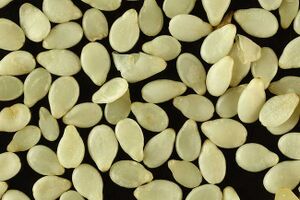
Sesame, also known as gingelli, is grown primarily for its oil-rich seeds, which come in a variety of colours, from cream-white to charcoal-black. In general, the paler varieties of sesame seem to be more valued in the West and Middle East, while the black varieties are prized in the Far East. The small sesame seed is used whole in cooking for its rich nutty flavour (although such heating damages their healthful poly-unsaturated fats), and also yields sesame oil.
Sesame seeds are sometimes added to breads, including bagels and the tops of hamburger buns. Sesame seeds may be baked into crackers, often in the form of sticks. Sesame seeds are also sprinkled onto some sushi style foods. Whole seeds are found in many salads and baked snacks as well in Japan. Tan and black sesame seed varieties are roasted and used for making the flavouring gomashio. In Greece seeds are used in cakes, while in Togo, seeds are a main soup ingredient. The seeds are also eaten on bread in Sicily and France (called "ficelle sésame", sesame thread). About one third of the sesame crop imported by the United States from Mexico is purchased by McDonald's for their sesame seed buns.
Ground and processed, the seeds can also be used in sweet confections. Sesame seeds can be made into a paste called tahini (used in various ways, including in hummus) and a Middle Eastern confection called halvah. In India, sections of the Middle East, and East Asia, popular treats are made from sesame mixed with honey or syrup and roasted (called pasteli in Greece).
Sesame seeds are a key ingredient in za'atar, a spice mixture that originates in the Middle East.
Great with:
Find recipes that contain 'Sesame'
#sesame #breads #lemon #spices #sesameoil #hummus #salads #honey #bagels #tahini #aubergines